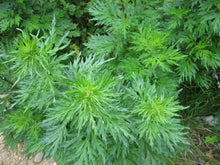
Common Name: mugwort
Type: Herbaceous perennial
Family: Asteraceae
Native Range: Europe to Iran and Siberia, northern Africa
Zone: 3 to 8
Height: 2.00 to 4.00 feet
Spread: 3.00 to 6.00 feet
Bloom Time: August to September
Bloom Description: Yellowish to reddish brown
Sun: Full sun
Water: Dry to medium
Maintenance: Medium
Suggested Use: Naturalize
Flower: Insignificant
Leaf: Fragrant
Attracts: Butterflies
Tolerate: Rabbit, Deer, Drought, Dry Soil
Best grown in poor to moderately fertile, dry to medium moisture, well-drained soils in full sun to part shade. Does poorly in moist to wet soils where plants are susceptible to root rot. Plant stems tend to lodge in the summer, especially if grown in fertile soils and/or significant shade. General foliage decline often occurs in high humidity summer climates such as the St. Louis area. If foliage declines or stems flop in summer, plants may be sheared to revitalize. Plants can spread aggressively in the landscape. Easily propagated by division. Notwithstanding historical uses, species’ plants are considered by many gardeners today as being not much more than roadside weeds.
Noteworthy Characteristics
Artemisia vulgaris, commonly known by a large number of common names including mugwort, wild wormwood, and felon herb, is an upright rhizomatous herbaceous perennial which grows 2-4’ (less frequently to 6') tall but spreads in the landscape by rhizomes, often aggressively, to 6’ wide or more.
It is native to and widespread in Europe and throughout northern Asia from Russia to Japan and Korea. It can be weedy and invasive, particularly in disturbed sites. It was introduced as an herbal plant into a number of sites in North America, starting with the first European visits in the early 1600's. Plants have naturalized over time throughout southern Canada, the eastern and Midwestern United States (Maine to Minnesota south to Florida and Louisiana) and in the Pacific Northwest (Washington, Oregon, Idaho and western Montana). It typically grows in loamy or sandy soils in forested areas, coastal strands and along roadsides.
Plants feature (a) angular reddish-brown stems, (b) aromatic, petiolate, deeply lobed and cut basal and middle leaves which grow to as much as 4” long, each leaf being deep green above and white tomentose beneath, (c) smaller and narrower cauline upper leaves which become linear in the flower panicles, (d) yellowish to reddish brown apetalous discoid flowers (to 1/8” across) which bloom late summer to early fall in dense leafy panicles, and (e) achenes which follow the flowers.
This species has a long history of human use in Europe and Asia as an herbal medicine. Leaves are technically edible, but bitter and toxic when consumed in quantity. Aroma from fresh or dried plant leaves will repel insects.








